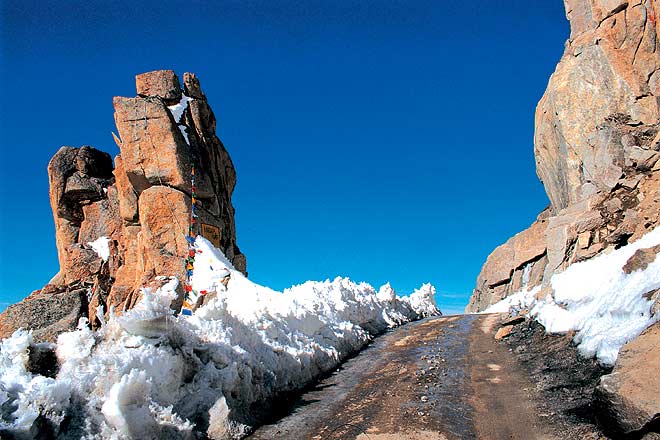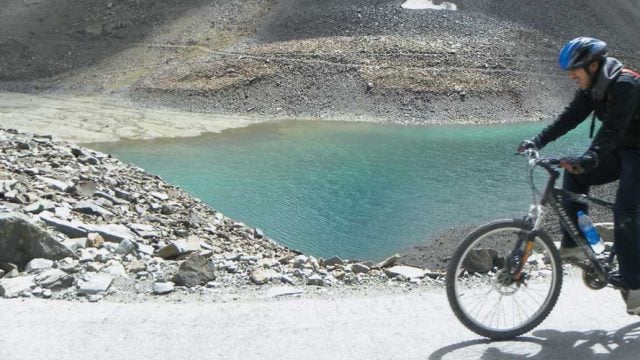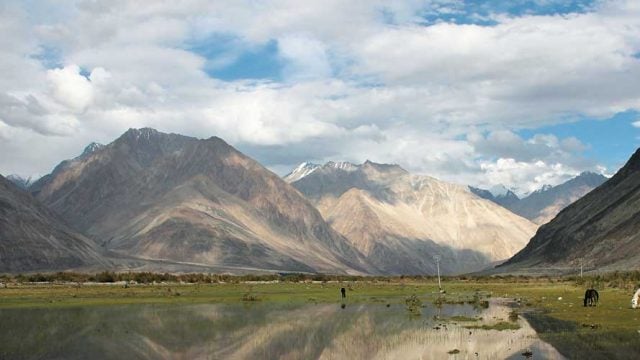Visitors to Ladakh may note, rising from the snow desert —
“The world’s highest road,” he said.“You’re kidding!” I stared at him. “So how do I get onto that?”
He laughed. “You don’t. It’s military, it leads to the Khardung La pass and, beyond, the Siachen Glacier. They’re fighting a war there, us versus Pakistan, so it’s off-limits. But it happens the man in charge of army roads is a friend; if I invite him to dinner you could at least learn something about it.”
Though the Serai, a collection of yurt-style bungalows perched at 11,500 feet, in the village of Stok, is known for its cuisine, Colonel Patel, a lean, rangy man with the swank of an ageing 1930s movie star, ate nothing at all. “I don’t take food,” he said, opting for rum instead. He was actually an army doctor who built and maintained roads because he loved the outdoor life. When I mentioned the one that interested me, however, he looked bleak. “Last week I lost a bridge at Khardung La — the world’s highest, knocked down by a glacier. In the process, I also lost three officers and five men. Their bodies are still lying in the ice.”
It was obvious I would be allowed nowhere near it but, next day, Ramesh said, “On Sunday, the 58th Gurkha Regiment is having a picnic to celebrate their return from the glacier. Colonel Patel has wangled invitations for us.”
In perfect picnic weather, we set off through those astonishing landscapes for some vaguely specified spot on the bank of the Zanskar river. Gurkhas kept stepping from behind rocks and issuing directions. We edged along an escarpment incorporating a dizzying drop to the Indus (a stream that hardly gave any indication it had travelled all the way from Tibet), passed a junction of the rivers, crossed a giant gorge, to finally arrive at a stretch of the Zanskar, noisy with tumbling snowmelt and, beside it, a broad riverine beach.
On it cookhouses, mess tents, latrines and a bandstand had been erected, while open parachutes suspended from poles provided shade. Colonel Patel, rum in hand, introduced us to the 58th’s debonair CO — another colonel. As young Indian officers, plainly shattered after six months on the glacier, wandered by swigging bottles of Rosy Pelican, the CO said, “They are all fluent in Nepali, you know. So are their wives.” He added, “You can only acclimatise the human body up to 18,000 feet so, on foot patrol at 25,000 feet, with crampons and ice axes, you must move very, very slowly.”
A young doctor, who had qualified only two years back, said, “In winter, the temperature is 60 degrees below zero — unless you fall into a crevasse. Then it drops a further 40 degrees.”
“Snow leopards are not uncommon,” a lieutenant told me. “One became so tame we put it in a cage, but HQ made us release it. Respect the environment, they said.”
I noted people throwing empty bottles into the Zanskar. That did not strike me as respecting the environment, but the CO shrugged.
After a fabulous Nepali meal, the six-man Gurkha band struck up. The CO’s wife, at the mike, sang Nepali pop songs as the Gurkhas danced beside the cold grey river and Colonel Patel’s wife, questioning me closely about my life, offered much thoughtful advice. As I rose to go she commanded, “Be happy!”
Next day I almost jumped for joy. A permit granting me access to the Khardung La — signed by her husband and copied to the Indo-Tibetan Border Force — arrived at the Serai. My guidebook said the world’s highest road was strictly off-limits and, due to frequent avalanches, dangerous.
“How do I get there?” I asked Ramesh.. “By taxi.”
I smiled. “I’m not joking,” he said. “The Ladakh Taxi Union wields great power. The reason I do not keep a car for my guests is because they forbid it.”
The mountains were still bathed in moonlight when my driver arrived. A friendly, mild-mannered man arrived with a small blue jeep (which he handled with great skill). At South Pulu, the 15,000-foot-high security checkpoint where two sleepy soldiers in heavy greatcoats demanded to see our papers, the road turned into a skiddy yak track cratered by fallen boulders. At 16,000 feet melting snow and ice released so much water that I worried about being washed over the edge.I could see mile-long vertiginous drops, only inches from our wheels; I also worried about the blind corners and military vehicles rounding them at speed.
Then, quite suddenly, we were there. “Khardung La,” murmured the driver, switching off the engine.
I climbed out. Beyond rows of faded prayer flags the Karakoram’s early morning dazzle seemed to light up Asia. A sign said, ‘Project Himank World’s Highest Motorable Road Altitude 18,380 ft.’ Another advised: ‘You Are Nearest to Heaven And Can Have a Dialogue With God.’ But for a distant generator misfiring in the thin air, it was very quiet. I spotted a tiny breeze-block temple, inside it examined a religious picture presented ‘by the Dozer Operators’. Rotting carpets covered the floor, tiny brass bells dangled from the tin roof. The place smelled of stale incense.
With a roar, a truck drew up outside. A young, nervy soldier appeared, bent to touch the lintel, rang the bells on his way into the shrine, rang a heavy Garhwal Rifles regimental bell suspended over it, rang the lesser ones again on his way out. I asked, “Have you been to the front?” He nodded.
“Taking them what?”
“Apple juice,” he said.
Strolling, I found the remains of ‘the World’s Highest Motorable Bridge’, lost by Colonel Patel. I looked across the Nubra valley towards the frozen battlefield, and chatted with the handful of people I came across. One, a lanky Delhi man having his hair cut, found it hard to believe I was in Khardung La of my own free will. He kept insisting it was an awful place and, when I said I found it exhilarating and beautiful, suggested I try staying for six months. “Instead,” he added waspishly, “of returning to hotel for lunch.”
Early in 2007, those memories returned with a rush, when the London Observer invited me to challenge the claim (made by one of its correspondents) that the magic had gone out of travel. I placed, at the heart of my case, this small Ladakhi adventure, and the way a mere taxi ride could lift the spirits, quicken the senses and keep one alive to a world which — despite the mess we’ve made of it — remains a place of infinite wonder.
Ladakh
world'd highest motorable road
Leave a Reply
You must be logged in to post a comment.





